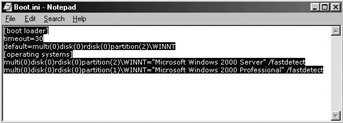Using the DOS Configuration Files
If you boot your computer using DOS as your operating system, DOS looks for two files during startup: CONFIG.SYS and AUTOEXEC.BAT. These files customize the configuration for your computer.
The main function of the CONFIG.SYS file is to configure system hardware and set the computer's environment parameters. The environment parameters include loading device drivers and setting the amount of memory DOS will use for applications.
The main function of the AUTOEXEC.BAT file is as a batch file that runs every time you start your computer. Common items in AUTOEXEC.BAT include programs that should run every time you start your computer and customization commands for your computer.
Both files are discussed further in the following subsections. In addition to these two files, a section on the BOOT.INI file has been included for anyone who will be working with a dual-boot computer.
CONFIG.SYS
CONFIG.SYS configures your computer's memory management, DOS settings, and device drivers. Here is a sample CONFIG.SYS file with commonly included items:
DEVICE=C:\DOS\HIMEM.SYS DEVICE=C:\DOS\EMM386.EXE NOEMS DOS=HIGH,UMB FILES=20 BUFFERS=30 DEVICE=C:\FUJITSU\ATAPI.SYS /D:OEMCD001
The first three lines represent options for configuring how memory is managed on your computer. DOS does not use the same memory management scheme as Windows 9x, Windows Me, Windows 2000, or Windows XP/Windows Server 2003. This means that without some type of memory manager, your computer can recognize only 640K of memory. For more information on memory management, you should consult a DOS manual.
The FILES=x option specifies how many file handles DOS can keep open at any time. File handles is a fancy way of saying open files. You should limit the number of open files to conserve memory.
The BUFFERS=x option specifies how much memory will be available to store information in RAM as opposed to disk. This is called caching. Requests that are handled through cache as opposed to disk are processed much more quickly.
The last line in the sample file represents a CD-ROM driver that is being loaded. Any other device drivers that need to be loaded would also be included.
AUTOEXEC.BAT
The AUTOEXEC.BAT file is a special batch file that loads or configures, without user input, any options that should be configured each time you start the computer or any programs that should be run. Here is a sample AUTOEXEC.BAT file:
PATH=C:\DOS;C:\WINDOWS;C:\WORD C:\DOS\SMARTDRV STARTNET
In this sample file, the first line sets up the path the computer will use. PATH tells the computer where it should look for executable files. For example, if you were in the C:\DOCS folder and you tried to execute WORD.EXE, the system would look in memory, then in the current folder, then in the folders listed in the PATH statement.
The second line specifies that the SMARTDRV program should be loaded. SMARTDRV improves system performance by accessing data from a disk faster.
The final line calls another batch file, STARTNET, which loads network services.
BOOT.INI
The BOOT.INI text file plays an important role on computers that dual-boot between any Microsoft Windows 9x operating systems, Windows Me, Windows NT, Windows 2000, and Windows XP/Windows Server 2003: It specifies the locations of the operating systems installed, provides for a default operating system to load, and displays a menu of the operating system choices available for the user to choose.
The BOOT.INI file is located at the root of the startup drive. The startup drive is usually the C drive. Inside the BOOT.INI file are commands that tell the computer to display a DOS menu during the boot process. The menu lists options for the user to select that will start one of any installed operating systems.

|
|